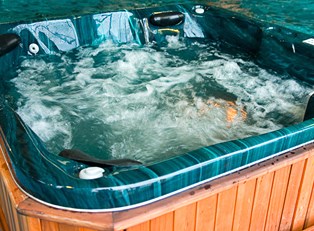While the terms hot tub and spa are often used interchangeably, there are differences between the two. They do share common features, such as relaxing, warm water and massaging jets that soothe tired muscles, yet there are important distinctions that determine whether a unit is a spa or hot tub.
Hot Tubs
Traditionally, hot tubs are made from wood, similar to wine barrels, using no nails or screws. The wood used is commonly redwood, oak, teak, cedar or cypress. Because there are no nails, the type of wood used is crucial to ensuring that the planks will swell enough to create a water-tight fit between the seams. The wood must also be resistant to rot caused by the water itself or damage from water treatment chemicals. While original hot tubs were typically only large enough to comfortably fit one or two people, modern tubs can be much larger. Other changes from the original may include a liner to protect the wood and fasteners to keep the unit together.
Spas
Spas are not made from wood. They are typically molded from acrylic or fiberglass into a variety of shapes and sizes. Spas that are attached to swimming pools are most often made of concrete. Spas have seats that are molded right into the unit, and they may have both a deep and a shallow side, accommodating those who wish to sit or stand.
Water Jets
Both hot tubs and spas have water jets built in that are directed at the bathers, but even with the jets there is a difference. Hot tubs most often have jets located around and beneath the seats. Spas have jets shooting directly up through the seats and floor. While they both have hot water and jets, the way you use the unit may influence where you prefer the jets be located, helping you understand whether you would prefer a hot tub or a spa.
Manufacturing Materials
One final difference between hot tubs and spas is portability. Because of the way they are manufactured and the materials used, hot tubs are rarely considered to be portable. They are heavy structures designed to be put into place and left permanently. Spas that are made of acrylic or fiberglass are lighter than hot tubs, their sizes and shapes vary, and they are often portable. Not only may some spas be moved if the owner relocates to a new home, but many are designed to be placed either indoors or outdoors at the owner's discretion. They can even be moved seasonally if it is desired.
Both spas and hot tubs are made to help you relax and unwind using warm water to lessen tension in the muscles. Knowing the difference between the features, materials, and designs will help you choose the right unit for you.



